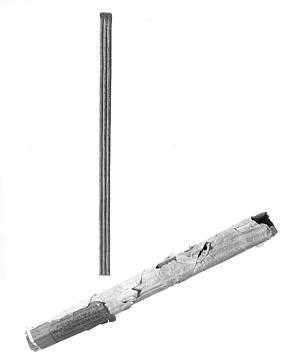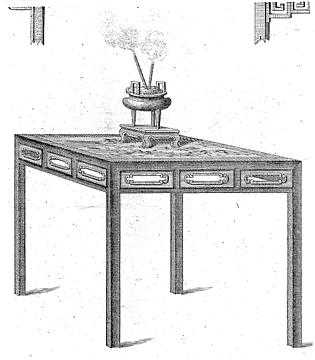Incense served many uses through the centuries in various parts of the world, and particularly in China and Japan. It was inevitable that eventually a new use would be found for it and that it would be applied for the measurement of time. The earliest forms developed from the rudimentary knotted match cord to incense sticks (known as senko in Japan), and incense coils. Eventually a more sophisticated use of the popular material was in elaborate powder trails.
The prevalence of incense timekeepers in China and Japan was reported again and again during the seventeenth, eighteenth and early nineteenth centuries by Western missionaries and travelers in East Asian countries. One of the earliest reports occurred in the diary of Matteo Ricci (1552-1610) founder of the Jesuit mission in China. In an entry probably written in about 1601 while he was in Beijing, he noted that in China there were few means for measuring time and these were by means of water or fire, and ". . . of those operated by fire, time is measured by an odorifierous ash, like the tinder sticks or touchwood of our guns."
In Japan the methods and devices for time measurement with incense subsequently paralleled those that had been developed in China, the knotted match cord, incense stick, incense coil and later in powder trails. According to the Tokei Hattatsu-Shi , a work on the "Development of Clocks" by Hyoe Takabayashi, punk or match cord was used by the Japanese in the same manner that it had been employed in China for timetelling purposes, and presumably the practice had been borrowed by the Japanese from the Celestial Empire.
The knotted match cord, the simplest form of incense time measurer, consisted of a length of specially prepared cord composed of punk which was knotted at measured intervals. Punk is made of dry decayed wood, or from a spongy substance prepared from fungi. Each of the spaces between knots would indicate a period in the passage of time measured by means of the progress of the cord' s burning. Punk, like incense, burns slowly and at an even rate, and the knotted cord was commonly used as a time alarm among the poorest classes. A length of match-cord made of punk, knotted for the period of time desired, was placed between the user's bare toes and ignited before the user, such as a military sentry on night duty, fell asleep. When the cord had burned down to the skin, he would be awakened, and undoubtedly his exclamation would unwittingly awaken the rest of the household or the barracks.
Incense produced in the form of incense sticks, also known as "joss sticks," has served from time immemorial in China and Japan as votive offerings burned in front of family and temple altars, as well as for time measurers. The incense stick was adopted in Japan for timetelling as a matter of course. Called senko and known in Japan as "Chinese matches," the most common type of stick was made from sandalwood and elm root that had been ground into a powder, mixed together with wood dust, then reduced to a paste by the addition of water. It was allowed to harden into thin straight sticks six or seven inches in length.
The time required for a stick's consumption when lighted was observed, and used as a standard time interval. The device was later refined by marking the stick along its length at such measured intervals with common time designations. Incense was a most desirable material for use as time measurers because it burned at a slow, constant rate without flame, and at the same time provided a fragrant atmosphere. A number of these sticks were then inserted vertically into a bed of powdered wood ash contained in a small urn or similar receptacle made of either baked clay, ceramic or metal. Once a stick was lighted, it was a simple matter to determine the passage of time by noting the number of horary marks remaining.
Another simple shape of incense for time measurement was in the form of a spiral coil, made by forcing the paste-like spaghetti through a drawplate to produce a coil. It was permitted to harden, then marked along its length with divisions for the hours. When the coil was suspended from its innermost end, it would hang down in the form of an attractive opened spiral. When lighted at its lowermost extremity, it burned slowly and at an even rate, indicating the time as it reached and passed each of the markings. This form of incense timepiece can be found suspended from the rafters of many Buddhist temples, where, however, its presence is votive only.
An unusual use of the incense stick in China was for a time alarm or alarm clock. A special vessel was created that measured about two feet in length, cast in bronze or carved in wood. It was shaped with the body of a dragon representing the ancient Dragon Boats used in the traditional annual Chinese festival that continues to be celebrated to this day.
The exterior of wooden examples was generally covered with black lacquer which was then painted with scales in gilt, and the head and tail also were rendered in gilt. The interior of the body of this highly decorated vessel was hollowed out and wire supports were inserted inside along its length. A long incense stick marked at intervals with the hours was placed upon the supports. This "Dragon Boat vessel," supported upon two wooden blocks was placed over a large flat copper or brass dish or platter.
A thin string, usually of silk, having a small metal weight or bell attached at each end, was stretched across the top of the vessel at a point along the marked incense stick chosen by the sleeper when he wished to be aroused.
The incense stick burned for the desired number of hours and when it reached the string, the string burned quickly and parted. As the small metal weights dropped into the dish, they made a brief tinkling sound, which presumably was sufficient to awaken the sleeper.
Related articles
Show moreSource
For a comprehensive history of the use of incense for time measurement in Japan see THE TRAIL OF TIME. Time Measurement With Incense in East Asia by Silvio A. Bedini (Cambridge: Cambridge University Press, 1999)
https://books.google.com.vn/books/about/The_Trail_of_Time.html?id=xdVkzs6iI1YC&redir_esc=y
Copyright information:
Copyright 2002 -- Silvio A. Bedini
This article is published on Naturalscents.net with permission from Silvio A. Bedini - https://en.wikipedia.org/wiki/Silvio_Bedini


![Figure 3. Incense sticks in a bronze bowl. [Right side of illustration]. From M. Planchon,](https://api.naturalscents.net/images/88/incense-sticks-in-a-bronze-bowl-original-b61b4d07-6d0e-465a-b124-86edf4cb58b6.jpg)










